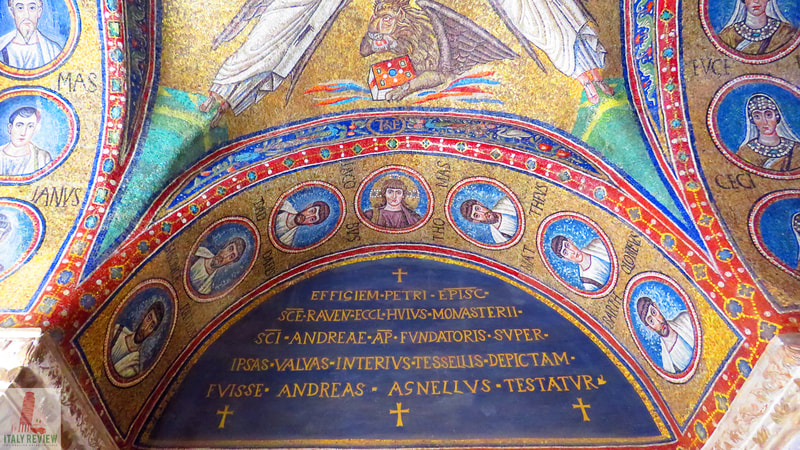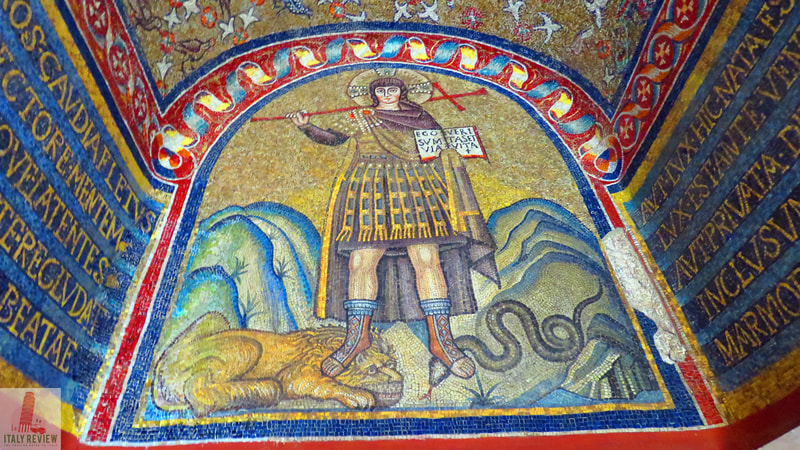Archiepiscopal Chapel - Cappella di Sant'Andrea
|
By Dion Protani
|
Latest update: 9 January 2024
|
|
The Archiepiscopal Chapel is also referred to as the Cappella di Sant'Andrea, the Chapel of Saint Andrew. It's housed within the Archiepiscopal Museum that forms part of Ravenna Cathedral.
One of eight sites that make up the Early Christian Monuments of Ravenna UNESCO World Heritage listing, it's most notable for the striking mosaics that were created at the time of its construction. |
Related links
Profile
The Archiepiscopal Chapel, also known as the Chapel of San Andrea or Sant'Andrea, is a small but historically significant religious building located in Ravenna, Italy. It is part of the wider complex of the Archiepiscopal Palace, which was once the residence of the archbishops of Ravenna.
The chapel dates back to the 6th century and was built during the Byzantine rule of Ravenna. It is particularly famous for its exquisite mosaic decorations, which are some of the finest examples of Byzantine art in Italy.
The chapel dates back to the 6th century and was built during the Byzantine rule of Ravenna. It is particularly famous for its exquisite mosaic decorations, which are some of the finest examples of Byzantine art in Italy.
Architecture
The Archiepiscopal Chapel is a compact, centrally planned building with an octagonal shape. The exterior of the chapel is relatively modest compared to other monumental buildings in Ravenna. However, the real treasures lie within its walls, where stunning mosaics cover almost every inch of the interior.
The dome of the chapel is adorned with a majestic mosaic depicting a cross in a starry sky, surrounded by heavenly figures. The walls and vaults feature scenes from the life of Christ and various saints, executed with incredible detail and rich colors.
The dome of the chapel is adorned with a majestic mosaic depicting a cross in a starry sky, surrounded by heavenly figures. The walls and vaults feature scenes from the life of Christ and various saints, executed with incredible detail and rich colors.
Key features and nearby attractions
- Location: The Archiepiscopal Chapel is located in the heart of Ravenna's historical center, within easy walking distance of other important attractions, such as the Basilica of San Vitale and the Mausoleum of Galla Placidia.
- Visiting Hours: The chapel is usually open to the public, and visitors can explore the interior to admire the beautiful mosaics. However, opening hours may vary depending on the season, so it's recommended to check ahead of your visit.
- Entry Fee: There is usually an admission fee to visit the chapel. Some sites in Ravenna offer combination tickets that provide access to multiple attractions, including the Archiepiscopal Chapel.
- Guided Tours: Guided tours are available for visitors who wish to gain deeper insights into the historical and artistic significance of the chapel and the other notable sites in Ravenna.
- Photography: Photography is generally allowed inside the chapel, so visitors can capture the beauty of the intricate mosaics.
- Religious Services: The Archiepiscopal Chapel is still used for religious services, and there may be occasional closures for private events or ceremonies.
- Preservation: Due to the historical and artistic importance of the mosaics, there are guidelines in place to preserve the delicate artworks. Visitors are usually asked to refrain from touching the mosaics or using flash photography.
Cappella Arcivescovile o di Sant'Andrea
|
Location: Archiepiscopal Museum
City: Ravenna Province: Ravenna Region: Emilia Romagna Built: 495 AD Architectural style: Paleochristian |
Opening times:
Times vary from month to month but typically: Summer 09:00 - 19:00 every day Winter 10:00 - 17:00 every day |
Ticket prices:
The €12:50 combined ticket includes entrance to the Neonian Baptistery, the Basilica di San Vitale, the Basilica di Sant'Apollinare Nuovo and the Mausoleum of Galla Placidia. Individual tickets to each site are not available.
When purchasing your ticket, you will be allocated a time to visit each location on that day. You can visit the monuments on different dates if required, with a total validity of seven days.
The €12:50 combined ticket includes entrance to the Neonian Baptistery, the Basilica di San Vitale, the Basilica di Sant'Apollinare Nuovo and the Mausoleum of Galla Placidia. Individual tickets to each site are not available.
When purchasing your ticket, you will be allocated a time to visit each location on that day. You can visit the monuments on different dates if required, with a total validity of seven days.
UNESCO World Heritage Site
Early Christian Monuments of Ravenna
Year: 1996
Early Christian Monuments of Ravenna
Year: 1996























